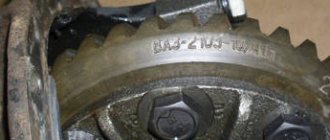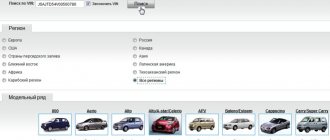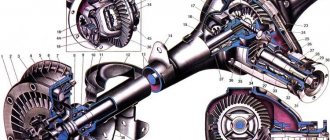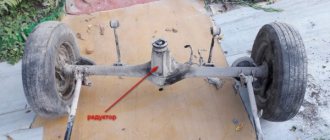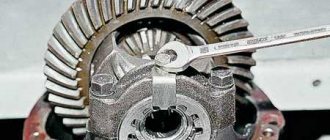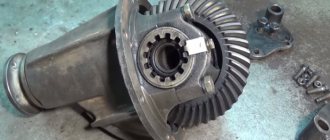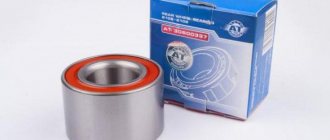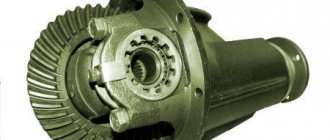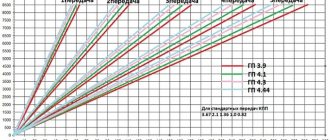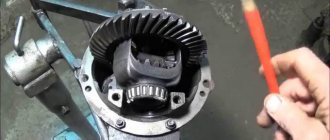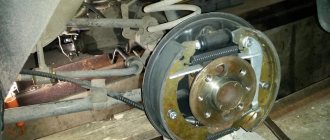| Engine | 1.2l, 8-cl. | 1.2l, 8-cl. | 1.3l, 8-cl. |
| Length, mm | 4073 | 4043 | 4043 |
| Width, mm | 1611 | 1611 | 1611 |
| Height, mm | 1440 | 1440 | 1440 |
| Wheelbase, mm | 2424 | 2424 | 2424 |
| Front track, mm | 1349 | 1349 | 1349 |
| Rear track, mm | 1305 | 1305 | 1305 |
| Ground clearance, mm | 170 | 170 | 170 |
| Minimum trunk volume, l | 325 | 325 | 325 |
| Body type/number of doors | Sedan/4 | ||
| Engine location | Front, longitudinal | ||
| Engine capacity, cm 3 | 1198 | 1198 | 1300 |
| Cylinder type | Row | ||
| Number of cylinders | 4 | 4 | 4 |
| Piston stroke, mm | 66 | 66 | 66 |
| Cylinder diameter, mm | 76 | 76 | 79 |
| Compression ratio | 8,5 | 8,5 | 8,5 |
| Number of valves per cylinder | 2 | 2 | 2 |
| Supply system | Carburetor | ||
| Power, hp/rev. min. | 64/5600 | 64/5600 | 70/5600 |
| Torque | 89/3400 | 89/3400 | 96/3400 |
| Fuel type | AI-92 | AI-92 | AI-92 |
| Drive unit | Rear | Rear | Rear |
| Gearbox type / number of gears | Manual/4 | Manual/4 | Manual/4 |
| Gear ratio of the main pair | 4,3 | 4,1 | 4,1 |
| Front suspension type | Double wishbone | ||
| Rear suspension type | Helical spring | ||
| Steering type | Worm gear | ||
| Fuel tank volume, l | 39 | 39 | 39 |
| Maximum speed, km/h | 140 | 142 | 145 |
| Vehicle curb weight, kg | 955 | 955 | 955 |
| Permissible total weight, kg | 1355 | 1355 | 1355 |
| Tires | 155 SR13 | 165/70 SR13 | 155 SR13 |
| Acceleration time (0-100 km/h), s | 22 | 20 | 18 |
| Fuel consumption in the urban cycle, l | 9,4 | 9,4 | 11 |
| Fuel consumption in the extra-urban cycle, l | 6,9 | 6,9 | 8 |
| Fuel consumption in the combined cycle, l | 9,2 | 9,2 | — |
Body weight
ATTENTION! A completely simple way to reduce fuel consumption has been found! Don't believe me? An auto mechanic with 15 years of experience also didn’t believe it until he tried it. And now he saves 35,000 rubles a year on gasoline! Read more"
Let’s say right away that the “six” weighs exactly 1045 kg. Its mass is decomposed as follows:
- The weight of the power unit together with additional equipment is 140 kg;
- The gearbox weighs about 26 kg;
- Shaft – 10 kg;
- Rear axle – 52 kg;
- Radiator – 7 kg;
- Body – 280 kg.
It turns out that the body is the heaviest part of the car. It is exactly twice as heavy as the engine. The remaining parts of the machine have approximately the same mass.
How many teeth are there on the VAZ classic gearboxes?
You can install any one in the rear axle gearbox of VAZ rear-wheel drive vehicles, regardless of the car model. The only exceptions are all-wheel drive VAZ models (Niva and its modifications). Regarding the latter, the rule is true: when repairing a gearbox (front or rear separately), it is necessary to ensure that the gear ratios of the main gears of both gearboxes match. Failure to comply with this rule will inevitably lead to breakage of the main gear teeth of one or both gearboxes immediately after the start of movement.
Body dimensions of the “six” and their verification
There is a concept of car body size. Along with this, it is customary to talk about geometric dimensions, which imply control standards and distances, the geometry of door and window openings, the distance between axes and much more.
As a rule, a car that has been in an accident is checked for displacement of the main body elements. Particular attention is paid to the following body parts:
- Diagonals. The car is driven onto the overpass, and then the distance from one extreme point of the floor to the other is checked diagonally using a tape measure. If there is a discrepancy between the distances on one side and the other, there is movement of the body;
- Racks. They are subject to mandatory verification. First of all, if the car has been in an accident, the whole side, not damaged, is diagnosed, and only then the damaged side.
Note. As for the choice of body points, in this case you can choose any. For example, you can select from the pillar to the extreme point of the rear door.
- Roof. To make sure that the roof is not leaking, you need to measure the dimensions of the doorways diagonally. The dimensions, of course, must match on both sides;
- Glass. The conformity of the windshield and rear windows is checked. Both are measured diagonally.
Main characteristics of the “six”
VAZ 2106 is considered a Soviet and Russian car, produced in the period 1975-2005. The car was manufactured and produced at VAZ, but already in 1998 some production facilities were moved to Syzran and Kherson. In 2002, the “six” was assembled at IzhAvto, where the last model of the legendary car was left on the assembly line.
It will be interesting to know: in total, over 4,300 million VAZ 2106 units have been produced in the entire history of the automotive industry at various factories.
The “Six” was also produced in several modifications. Regarding the body, the following noteworthy points can be made:
- The modification of the VAZ 21061, intended for sale in Canada, had a completely different body installed. This one had special aluminum bumpers and fangs. The bumper also had trims and ends made of black plastic;
- The VAZ 21063 body was equipped with “five” bumpers;
- The body of 21065 was also equipped with aluminum bumpers, and some of the cars going for export were generally modified;
- The VAZ 2121 was equipped with a body with the same bumpers as on the export 21061, only without sidelights.
As for specialized modifications:
- The “six” was produced in a pickup truck. It was a modification of the "Tourist". The pickup truck had a tent built into the bed;
- A single copy of the “six” called “half past six” was produced by order of Leonid Ilyich. It was equipped with a different hood, modified for this modification.
Note. An interesting fact: according to the norms of Soviet industrial economics, the “six” with its dry weight of 1045 kg fell into the group of small class cars, but in terms of the volume of the power unit it fell into the third group.
The body of the “six” and its mass played an important role in compiling the technical data of the car.
Article: 21060-2402010-00, additional articles: 21060240201000, 2106-2402010
Order code: 002789
- You may need
- show more
- Passenger cars / VAZ / VAZ-21061 drawing
» href=»/catalog/vaz-3/legkovye_avtomobili-30/vaz_2106-7/peredacha_glavnaya_i_differencial-114/#part20867″>Rear axle gearboxRear axle / Main transmission and differential
- » href=»/catalog/vaz-3/legkovye_avtomobili-30/vaz_2120__nadejda_-245/reduktor_i_differencial_zadnego_mosta-120/#part56701″>Rear axle gearboxRear axle / Rear axle gearbox and differential
- » href=»/catalog/vaz-3/legkovye_avtomobili-30/vaz_2105-603/peredacha_glavnaya-71/#part1679377″>Rear axle gearboxRear axle / Main gear
- » href=»/catalog/vaz-3/legkovye_avtomobili-30/vaz_21213_214i-1240/reduktor_i_differencial_zadnego_mosta-203/#part2990163″>Rear axle gearboxRear axle / Rear axle gearbox and differential
- » href=»/catalog/vaz-3/legkovye_avtomobili-30/lada_4x4_m-1456/reduktor_i_differencial_zadnego_mosta-149/#part3241383″>Rear axle gearbox assemblyRear axle / Rear axle gearbox and differential
- » href=»/catalog/vaz-3/legkovye_avtomobili-30/vaz_2107-8/peredacha_glavnaya_i_differencial-155/#part25128″>Rear axle gearboxRear axle / Main transmission and differential
- » href=»/catalog/vaz-3/legkovye_avtomobili-30/vaz_2131-73/reduktor_i_differential_zadnego_mosta-196/#part64636″>Rear axle gearboxRear axle / Rear axle gearbox and differential
- » href=»/catalog/vaz-3/legkovye_avtomobili-30/vaz_21213-731/reduktor_i_differential_zadnego_mosta-149/#part2010787″>Rear axle gearboxRear axle / Rear axle gearbox and differential
- » href=»/catalog/chevrolet-125/legkovye_avtomobili-30/chevrolet_niva_1_7-1233/reduktor_i_differencial_zadnego_mosta-171/#part2974699″>Rear axle gearbox assemblyAxles / Rear axle gearbox and differential
- There are no reviews for this product yet.
Today, the next article in the series “Crystal VAZs or typical breakdowns of domestic cars” is dedicated to the “classics”: VAZ-2101, 2103, 2104, 2104, 2105, 2106 and 2107. These cars have been driving along our roads for decades and, despite Despite all the shortcomings that we will talk about, their popularity is still high.
Dependence of acceleration parameters on mass
Engineers and designers know that there are a couple of classic methods to help improve vehicle data. And weight, or rather its ratio, plays almost the most important role in this matter.
Purely hypothetically: if you reduce the weight of the “six” by 10 percent, then the acceleration time to hundred (as we remember, it was 16 seconds) will also decrease by 10 percent. And this is already 15 seconds, which, you agree, is a good result.
To be specific, such a linear relationship between weight and acceleration only works in airless space, that is, in space. In fact, the car does not increase its parameters after 130 km/h, since it is impossible not to take into account the ASV (aerodynamic impact). And no matter how you reduce the weight of the car, you won’t help the matter. She will devote a lot to overcoming resistance. For example, if the power is 80 hp, then 40 hp. will definitely go to resistance, and the other half to acceleration.
It turns out that on cars with more power, weight reduction will have a more positive effect. The power unit still has a lot of power left for acceleration.
Another interesting point concerns the following. During maximum acceleration, the rear axle of the “six” is loaded. A portion of the weight moves from the front to the rear. For a rear-wheel drive car, this is only for the better - road traction becomes more effective. For the same reason, if we are talking about reducing weight on the “six”, it is recommended not to touch the rear, but to localize efforts to unload the middle and front zones.
Note. Another advantage in this regard can be considered the transfer of some components from the hood to the luggage compartment. For example, it could be a battery, washer reservoir, etc.
A few tips to ease the “six”
In order to make the VAZ 2106 a little lighter, it is recommended to do the following:
- Operate the vehicle with an incomplete fuel tank. As you know, a tank filled to the brim means an extra 80 kg of weight, which will certainly affect acceleration and fuel consumption.
- Some experienced drivers also keep the washer reservoir empty - an extra 4-15 kg of weight.
- Carrying a spare tire with you is, of course, correct. But without a spare wheel, the car loses about 12-25 kg, and this is no longer trivial.
- A lot also depends on the type of disk. Thus, it is recommended to use forged wheels. They reduce not only the total, but also the inertial mass by 10-20 kg.
- It is advisable to install the lightest battery. So, a 70-amp battery weighs 5 kg more than a 55-amp battery. We draw the appropriate conclusions.
Rear gear ratios of other cars
The gearboxes of VAZ cars are more or less clear. What about other cars? For example, the Gorky Automobile Plant has a large number of modern models of both medium-duty and passenger trucks. The most popular GAZ models are the Gazelle GAZ-3302 and Sobol GAZ-2752. If we do not consider all-wheel drive modifications of these cars, then the rear gear ratio will be either 5.125, or 4.556, or 4.3.
The highest-torque gearbox went to GAZ vehicles with ZMZ406 and ZMZ402 engines. It has the best power characteristics and is recommended for car owners transporting heavy loads and working in harsh conditions. A gearbox with a lower number will give greater dynamics, like a faster one. In this case, a relatively shorter service life should be noted.
To complete the picture, let’s consider foreign versions of gearboxes and their numbers. A good option for comparison would be the rear-wheel drive models of the German auto giant BMW. BMW gear ratios range from 3.07 to 4.1. Moreover, the number of unit models exceeds ten. Just from this indicator you can understand how often foreign designers make changes to car components.
The most dynamic gearbox with a number of 3.07 is found in models of the E90, E91 and E92 series. If we look at powerful options, we can highlight the BMW X5 with a 3-liter engine, which has a rear gear ratio of 4.1.
How much does the rear axle of a VAZ 2106 weigh?
VAZ 2121
Front
length in compressed position (length measured at the centers of the eyes and the middle of the pins) - 220 mm; stroke - 83.5 mm; rod diameter - 11 mm; tank diameter - 41.5 mm; casing diameter - 50 mm;
Nominal forces at a piston speed of 0.31 m/s, N (kgf) - during the rebound stroke - 120.154 kgf; — during the compression stroke — 17.31 kg.
length in compressed position (length measured at the centers of the lugs and the centers of the pins) - 310.5 mm; stroke - 181.5 mm; rod diameter - 11 mm; tank diameter - 41.5 mm; casing diameter - 50 mm;
Nominal forces at a piston speed of 0.31 m/s, N (kgf) - during the rebound stroke - 114.146 kgf; — during the compression stroke — 22.36 kg.
Shock absorbers VAZ 2123 Front
Connecting dimensions (mm) Maximum 351 Minimum 233
Piston stroke, mm 118
Nominal forces at piston speed 0.31 m/s, N (kgf) compression stroke 329 (33.57) rebound stroke 1740 (177.5)
Connecting dimensions (mm) Maximum 526 Minimum 326
Piston stroke, mm 200
Nominal forces at piston speed 0.31 m/s, N (kgf) compression stroke 329 (33.57) rebound stroke 1740 (177.5)
[img] The reviews are very positive, probably this is not important for the horizontal position of the pendulum. But this scheme has two other drawbacks - delicate SHSs and a lift of more than 4 inches is required.
The rear axle of the VAZ 2101-07 weighs 52 kg The rear axle of the M 412 weighs 55 kg The rear axle of the GAZ 24 weighs 85 kg The rear axle of the GAZ 13 weighs 95 kg The rear axle of the Niva weighs 61 kg The rear axle of the UAZ 469B weighs 100 kg The rear axle of the UAZ 469 weighs 125 kg Rear axle Gas 66 weighs 250 kg (gear ratio 5.5 and 6.cool.gif Rear axle VAZ-21213 - 62 kg GAZ-21 axle - 89 kg, UAZ collective farm axle - 100 kg, UAZ military axle - 121 kg. Front axle Niva -41 kg Front suspension beam VAZ-2121-24 kg front suspension assembly VAZ-2121-135kg Front axle UAZ-452 simple - 131.2 kg Gearbox Gas-66 74kg Transfer case "Niva" -25 kg UAZ -37 kg Gas66- 50-60kg (1-1.982) UAZ gearbox weighs 28kg Gas66-50-60 gear ratios (I-6.55; II-3.09; III-1.71; IV-1.0)
Weight of UAZ springs kg UAZ-452 front assembly 20.9 UAZ-3151 front assembly 17.7 UAZ-469 rear assembly 23.3 UAZ-469BG rear spring 19.4 UAZ-452 1 leaf front with / h 2.9 UAZ-452 2 leaf front with /h 2.9 UAZ-469 1 sheet of front 4.1 UAZ-469 2 sheet of front 4.0 UAZ-469 1 sheet of rear 4.5 UAZ-469 2 sheet of rear 4.4
WEIGHT OF UNITS auto. UAZ: 469B/469(reduced)
engine with equipment and clutch. 170/172 gearbox. 33.5 transfer case. 37.4 driveshafts. 15 front axle. 122/145 rear axle. 100/125 body assembly. 475 frame. .112 wheel and tire assembly. 38.6 radiator. 12
I note that the UAZ can be lightened by almost 500 kg by throwing out the body.
ICE VAZ-21083 with all attachments 96 kg Weight of VAZ 1111 Oka units (in kg): Engine power is 30 hp, base torque (50 Nm) 4.51 kgcm (3400 rpm) Gearbox ratios: I 3.7 II 2.06 III 1.27 IV 0.9 reverse 3.67 Final drive ratio 4.1 or 4.3 Engine assembly without clutch and gearbox - 66.5; gearbox with differential - 24.5 body assembly without upholstery and seats - 172; At 3400 rpm ICE = 4.5 kgcm Gearbox = 16.6 kgcm GP = 71.7 kgcm
TORQUE ICE Gas-53 26-29 kgcm at 2200-2500 rpm UAZ-469 17 kgcm at 2200 VAZ 2101-07 8.7 kgcm and 9.6 kgcm at 3400 Gas66 30 kgcm at 2000-2500 rpm UAZ Patriot 22 kgcm at 2 500rpm T-16 10.5 kgcm and 11 .5 kgcm at 1500-2000rpm Zil 157 35 kgcm at 1400rpm
Gear ratios: Model. GAS. M. VAZ. VAZ. VAZ Stage. 24. 412. 2101. 2105. 2106
1st. 3.50. 3.49. 3.75. 3.67. 3.24 2nd. 2.26. 2.04. 2.30. 2.10. 1.98 3rd. 1.45. 1.33. 1.49. 1.36. 1.29 4th. 1.00. 1.00. 1.00. 1.00. 1.00 ZH. 3.54. 3.39. 4.1. 3.53. 3.34
Transfer case VAZ 2121 Transfer case ratios, high gear 1.2 Transfer case ratios, low gear 2.135
Well, and finally, our Typical values of GP 3.9; 4.22; 4.55
Gear ratios of the VAZ-2107 four-speed gearbox
First transfer. 3.67 Second gear. 2.10 Third gear. ………..1.36 Fourth gear. 1.00 Reverse. 3.53 Main pair of rear axle gearbox with this gearbox. 3.9
MOTORCYCLES! Dnepr I-4.11 II-2.28 III-1.70 IV-1.30 z.kh.-3.67 GP 3.89 or 4.62 Gear ratio of winch gas-66 1:21 btr 1:23
Symptoms of a problem
As soon as the driver notices any changes in the operation of the rear axle (for example, extraneous sounds appear that were not there before), he must respond to these changes as quickly as possible so as not to aggravate the possible malfunction. The most typical sign of such problems may be increased noise levels:
- coming from the rear wheels;
- during operation of the rear axle;
- when accelerating the car;
- when braking with the engine;
- during engine acceleration and braking;
- while the vehicle is turning.
In addition, a knocking sound when the car starts moving and an oil leak may indicate a malfunction of the rear axle.
Oil leakage indicates a malfunction of the rear axle of the VAZ 2107
Grinding noise when moving
The causes of a grinding noise from the rear axle when the vehicle is moving can be:
- wear or destruction of axle or differential bearings;
- deformation of the beam or axle shafts;
- incorrect adjustment, damage or wear of gears or bearings of the gearbox and differential;
- wear of the spline connection with the semi-axial gears;
- incorrect adjustment of the gear teeth of the main gear;
- insufficient amount of oil.
The cardan spins, but the car does not move
If the driveshaft rotates while the vehicle is stationary, the cause may be a failed axle spline or wear on the teeth of the differential or final drive gears. In any case, if the cardan spins, but the car does not move, this indicates a fairly serious breakdown and, most likely, replacement of the axle shafts, bearings or gears will be required.
Oil leakage from the housing and from the shank side
The most likely causes of oil leakage from the rear axle housing:
- wear or damage to the drive gear seal;
- wear of the axle shaft seal, determined by oiling of the brake shields, drums and pads;
- loosening the bolts securing the rear axle gearbox housing;
- damage to sealing gaskets;
- axial play of the shank;
- breather jamming.
Wheels are stuck and won't rotate
If the rear wheels are jammed, but the drum and pads are in order, the cause of this malfunction may be failure of the bearings or the axle shaft itself. Most likely, in this case, the bearings have crumbled or the axle shaft has become deformed (for example, due to an impact) and the parts need to be replaced.
Body dimensions of the “six” and their verification
There is a concept of car body size. Along with this, it is customary to talk about geometric dimensions, which imply control standards and distances, the geometry of door and window openings, the distance between axes and much more.
As a rule, a car that has been in an accident is checked for displacement of the main body elements. Particular attention is paid to the following body parts:
- Diagonals. The car is driven onto the overpass, and then the distance from one extreme point of the floor to the other is checked diagonally using a tape measure. If there is a discrepancy between the distances on one side and the other, there is movement of the body;
- Racks. They are subject to mandatory verification. First of all, if the car has been in an accident, the whole side, not damaged, is diagnosed, and only then the damaged side.
Note. As for the choice of body points, in this case you can choose any. For example, you can select from the pillar to the extreme point of the rear door.
- Roof. To make sure that the roof is not leaking, you need to measure the dimensions of the doorways diagonally. The dimensions, of course, must match on both sides;
- Glass. The conformity of the windshield and rear windows is checked. Both are measured diagonally.
Main characteristics of the “six”
VAZ 2106 is considered a Soviet and Russian car, produced in the period 1975-2005. The car was manufactured and produced at VAZ, but already in 1998 some production facilities were moved to Syzran and Kherson. In 2002, the “six” was assembled at IzhAvto, where the last model of the legendary car was left on the assembly line.
It will be interesting to know: in total, over 4,300 million VAZ 2106 units have been produced in the entire history of the automotive industry at various factories.
The “Six” was also produced in several modifications. Regarding the body, the following noteworthy points can be made:
- The modification of the VAZ 21061, intended for sale in Canada, had a completely different body installed. This one had special aluminum bumpers and fangs. The bumper also had trims and ends made of black plastic;
- The VAZ 21063 body was equipped with “five” bumpers;
- The body of 21065 was also equipped with aluminum bumpers, and some of the cars going for export were generally modified;
- equipped with a body with the same bumpers as on the export 21061, only without sidelights.
As for specialized modifications:
- The “six” was produced in a pickup truck. It was a modification of the "Tourist". The pickup truck had a tent built into the bed;
- A single copy of the “six” called “half past six” was produced by order of Leonid Ilyich. It was equipped with a different hood, modified for this modification.
Note. An interesting fact: according to the norms of Soviet industrial economics, the “six” with its dry weight of 1045 kg fell into the group of small class cars, but in terms of the volume of the power unit it fell into the third group.
The body of the “six” and its mass played an important role in compiling the technical data of the car.
Dependence of acceleration parameters on mass
Engineers and designers know that there are a couple of classic methods to help improve vehicle data. And weight, or rather its ratio, plays almost the most important role in this matter.
Purely hypothetically: if you reduce the weight of the “six” by 10 percent, then the acceleration time to hundred (as we remember, it was 16 seconds) will also decrease by 10 percent. And this is already 15 seconds, which, you agree, is a good result.
To be specific, such a linear relationship between weight and acceleration only works in airless space, that is, in space. In fact, the car does not increase its parameters after 130 km/h, since it is impossible not to take into account the ASV (aerodynamic impact). And no matter how you reduce the weight of the car, you won’t help the matter. She will devote a lot to overcoming resistance. For example, if the power is 80 hp, then 40 hp. will definitely go to resistance, and the other half to acceleration.
It turns out that on cars with more power, weight reduction will have a more positive effect. The power unit still has a lot of power left for acceleration.
Another interesting point concerns the following. During maximum acceleration, the rear axle of the “six” is loaded. A portion of the weight moves from the front to the rear. For a rear-wheel drive car, this is only for the better - road traction becomes more effective. For the same reason, if we are talking about reducing weight on the “six”, it is recommended not to touch the rear, but to localize efforts to unload the middle and front zones.
Note. Another advantage in this regard can be considered the transfer of some components from the hood to the luggage compartment. For example, it could be a battery, washer reservoir, etc.
A few tips to ease the “six”
In order to make the VAZ 2106 a little lighter, it is recommended to do the following:
- Operate the vehicle with an incomplete fuel tank. As you know, a tank filled to the brim means an extra 80 kg of weight, which will certainly affect acceleration and fuel consumption.
- Some experienced drivers also keep the washer reservoir empty - an extra 4-15 kg of weight.
- Carrying a spare tire with you is, of course, correct. But without a spare wheel, the car loses about 12-25 kg, and this is no longer trivial.
- A lot also depends on the type of disk. Thus, it is recommended to use forged wheels. They reduce not only the total, but also the inertial mass by 10-20 kg.
- It is advisable to install the lightest battery. So, a 70-amp battery weighs 5 kg more than a 55-amp battery. We draw the appropriate conclusions.
More tips regarding more bodywork:
- Welding the frame will not only increase the rigidity characteristics of the body, but also significantly reduce the weight. The fact is that in this case an unnecessary, extra piece of metal is cut out of the body (no longer needed to maintain rigidity). In addition, it will be possible to install lightweight doors;
- You can replace standard heavy glasses with polycarbonate ones. This will reduce the weight of the car by 30-50 kg;
- You can install bumpers made of lightweight materials instead of standard ones. It will also be necessary to remove standard fasteners and clamps, which will ultimately result in a weight reduction of 20-70 kg;
- The hood and trunk can be replaced with similar ones, but made of composite materials;
- The audio systems in the car, including speakers and a huge subwoofer, also affect the mass;
- You can replace the seats with sports ones;
- Muffler tuning, carried out correctly, results in a weight reduction of up to 40 kg;
- Lightening the power unit by replacing cast iron manifolds;
- Installing a light flywheel results in a reduction of 3-8 kg;
- Standard suspension elements can be replaced with tuning ones, aluminum levers can be installed;
- Replace the steering wheel and gear shift knob.
Remember that the weight of the VAZ 2106 body affects not only the acceleration of the car, but also its other important parameters. Reducing weight affects good handling, braking and much more.
The instructions for lightening the weight of a car given above are not the only one of its kind. Every driver acquires valuable knowledge over time and uses it. In general, competent tuning of a car can be done with your own hands, if you know the nuances and technical data of a particular car model. Videos and photos will greatly help in this matter.
Features of car recycling
Before you scrap your car, you should familiarize yourself with the principles of this procedure. The average weight of a vehicle is 1000 kg. If the entire car can be recycled, the collection point will deduct 30% for clogging. The latter includes all non-metallic elements, pollution, etc.
Let's consider how much a car for scrap metal weighs using the example of a VAZ 2105. The weight of the latter is 955 kg. Thus, taking away the blockage, we get about 660 kg. You should also take into account the price of scrap, which differs depending on the city. As a rule, in megacities, the number of rubles received for a car will significantly exceed the amount earned in a similar organization in a small locality.
Before calculating the profit from a scrapped car, you need to take into account transportation costs. If the car is a pile of metal, you need to take care of a tow truck. If there are spinning wheels and functional steering, the car can be transported in tow. Then, this expense item will not be so significant. Therefore, in order to calculate how much a Zhiguli costs when scrapped, it is not enough to know how much a VAZ 2109 or 21099 weighs for scrap metal (915 kg). It is necessary to take into account the features of recycling and the requirements of collection points. It would be useful to know the average cost of scrap metal in the region. Additional awareness will allow you to avoid fraud on the part of unscrupulous receivers.
Despite the fact that disassembling a car is a labor-intensive procedure, many owners still decide to take this step. Thus, you can sort ferrous and non-ferrous metals and hand them over separately, removing the good parts. From an economic point of view, the procedure will be justified.
Let's consider how much a VAZ 2106 weighs for scrap metal based on individual significant structural elements:
It should be noted that dismantling machine parts requires a lot of time and certain skills. In the absence of the latter, it would be more rational to recycle it entirely.
